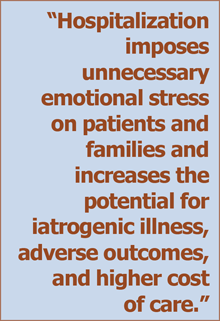Synopsis
A study of nursing homes in New York State identified steps that could potentially reduce the need to hospitalize residents. Among them are: training nursing staff to communicate effectively with physicians, providing more rapid access to laboratory results on weekends, and treating hospitalization as a last resort.
The Issue

Up to 40 percent of hospitalizations of nursing home residents could be avoided with more timely diagnosis and treatment of medical conditions. Admissions put patients at risk for hospital-acquired infections and other adverse outcomes, and they are costly as well. One study estimates that at least $223.8 million was spent on potentially avoidable hospital admissions for nursing home residents in New York State in 2004. In this Commonwealth Fund–supported study, researchers identified characteristics of nursing homes associated with low rates of preventable hospitalizations.
Key Findings
- The following were associated with a decreased rate of potentially preventable hospitalizations: nursing staff trained to communicate effectively with physicians about a patient's condition; access to urgent laboratory results in less than four hours on weekends; use of hospital admission as a last resort; and higher enrollment of residents in managed or long-term care plans.
- Nursing staff who received communication training had 20.2 fewer hospitalizations related to ambulatory care–sensitive (ACS) conditions per 100,000 resident days than staff who did not receive training. This translates to 3 percent fewer potentially preventable hospitalizations and $6.7 million in cost savings.
- Easy access to urgent lab results in less than four hours on weekends led to 9.3 fewer ACS hospitalizations, translating to a 1.4 percent reduction in hospitalizations and approximately $3.1 million in cost savings.
- Hospitalization rates were higher among residents whose families indicated a preference that acute conditions be treated in the hospital; rates were also higher when there was inadequate access to patients' prior medical histories.
Addressing the Problem
The study provides guidance for nursing homes, regulators, and quality improvement organizations seeking to reduce potentially preventable hospital admissions from nursing homes. The authors recommend that institutions focus on improving staff training, ensuring rapid access to prior medical history and test results, and encouraging physicians to treat residents within the nursing home whenever possible. Nursing homes may also benefit from fostering discussions with patients' family members about the hazards of treating subacute conditions in hospitals.
About the Study
The authors grouped all New York State nursing homes according to their ambulatory care–sensitive (ASC) hospitalization rates (high, medium, and low), which measure rate of hospitalizations for conditions that can be properly treated in ambulatory settings—such as asthma and hypertension. They then randomly selected nursing homes from these groups to participate in a survey, which asked nursing directors about nursing home facility environment, nurse and aide services, and resource availability, among other factors.
The Bottom Line
Potentially preventable hospital admissions may be reduced by increasing staff training to ensure effective communication, ensuring rapid access to laboratory results and patients' medical histories, and encouraging physicians to treat residents within the nursing home whenever possible.


